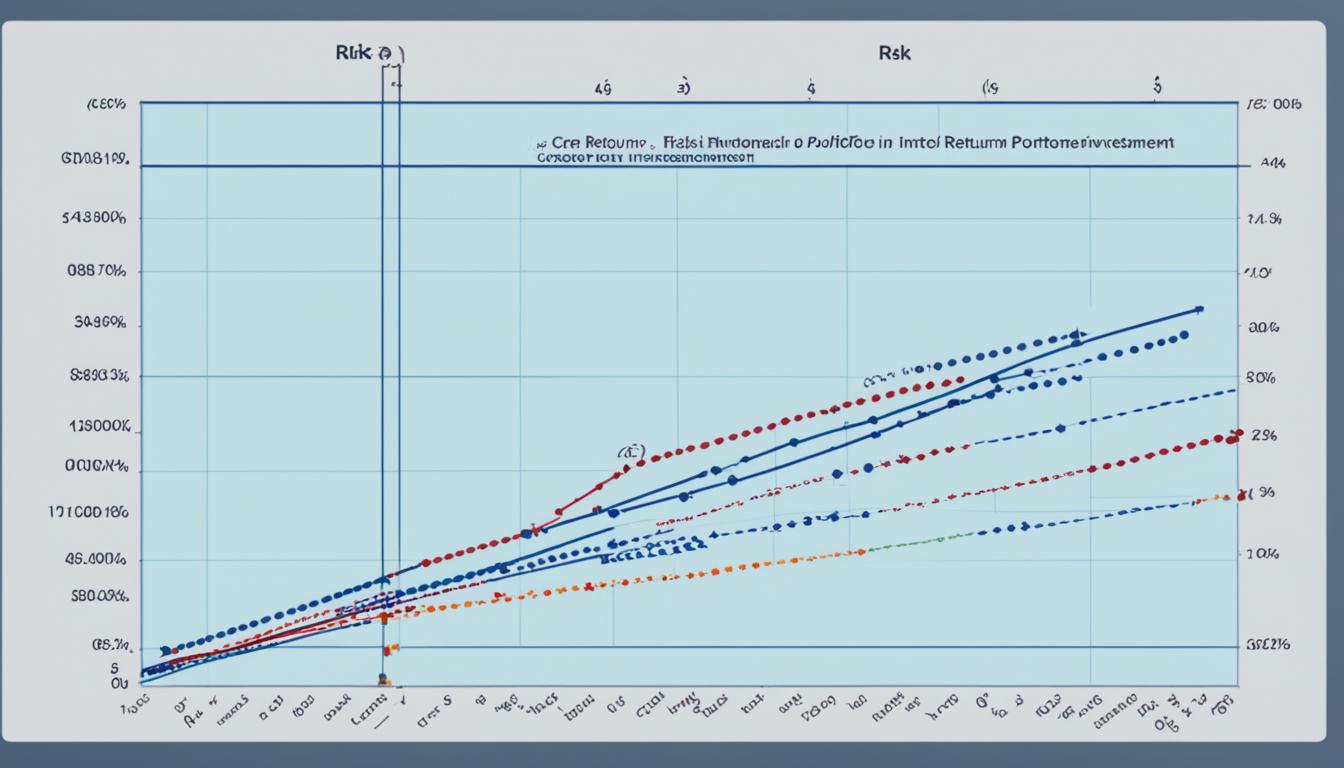In today’s fast-paced financial markets, it’s important to manage risks in your portfolio to boost returns. A portfolio risk optimization strategy does more than safeguard investments. It also increases the return on investment. By keeping an eye on market trends and conducting thorough financial portfolio analysis, investors can reach their goals with customized risk management.
Key Takeaways
- Optimizing risk within a portfolio is essential for maximizing returns.
- Well-structured risk optimization strategies protect investments.
- Understanding market trends is critical for effective financial portfolio analysis.
- Tailored risk management approaches significantly impact return on investment.
- Achieving desirable outcomes requires a balance of risk and potential returns.
Understanding Portfolio Risk Optimization
Portfolio risk optimization balances potential returns with a level of risk you’re comfortable with. It’s key for both personal and big investment plans.
What is Portfolio Risk Optimization?
Portfolio risk optimization uses risk tools to match financial goals with risk comfort. By looking at asset movement and how they relate, investors can aim for high returns but less loss potential.
Importance in Investment
Keeping investment risk low is crucial to avoid big money loss. With thoughtful risk checking, investors and finance groups can keep their portfolios strong and flexible. Knowing how risk tools work matters a lot in this.
Basic Concepts and Principles
Risk tolerance shows how well someone can handle market ups and downs without changing their plan. Asset volatility tells us how much asset prices can change. Correlation helps see how different asset prices move together, which helps spread out risk.
Here’s a simple guide to the key ideas:
- Risk Tolerance: Your ability to deal with changes in the market.
- Asset Volatility: How much the value of assets can go up or down.
- Correlation: It shows the link between how asset prices move, crucial for spreading risk.
Tools like Value at Risk (VaR) and stress tests are very important in making portfolios better. They let investors figure out possible losses and make smart choices to keep their investments balanced.
Effective Risk Management Strategies
Smart investing means using strong risk management strategies to protect your money from big losses. We’ll talk about important steps like investment diversification and hedging techniques. These help build a solid plan for lowering risk.
Diversification
Investment diversification means putting your money in different types of assets and places. This way, you won’t be too affected by one asset or market’s ups and downs. A good mix might include stocks, bonds, real estate, and more. These don’t all move up or down at the same time.
Hedging Techniques
Another crucial part of risk management strategies is hedging techniques. These methods use special financial products like options and futures. They help cancel out possible investment losses. For instance, if you own a lot of stock in one company, buying put options can save you from a big price drop.
Risk Assessment Tools
Good risk management also means knowing how to use risk assessment tools. Tools like Value at Risk (VaR) and stress testing help imagine worst-case scenarios. VaR tells you the most you could lose in a certain time, given the risks. Stress testing looks at how your investments might do in really bad market conditions.
To manage risks effectively, combine investment diversification, hedging techniques, and risk assessment tools. This way, investors can shield their portfolios and keep their investments safe.
Investment Diversification for Reduced Risk
Diversifying your investments is key to managing risk. This strategy includes reducing risk across your entire portfolio. It means spreading your investments over different types and market areas. This way, if one investment does badly, it won’t hurt your whole portfolio too much.
By holding assets like stocks, bonds, real estate, and commodities, your portfolio becomes more stable. Since each kind responds differently to economic changes, gains in one can help cover losses in others. This balance is a big plus of diversifying.
Diversification isn’t just about different asset types. It’s also about investing in various market sectors like tech, healthcare, and manufacturing. This ensures that a slump in one area doesn’t drag down your entire investment. Different sectors react differently to economic trends, adding another protective layer.
Diversified investing shines by lowering specific risks. While you can’t get rid of all market risks, you can reduce those tied to single investments. This cautious approach helps keep your portfolio stable, even when markets are unpredictable.
Advanced Asset Allocation Techniques
Advanced asset allocation is key for a balanced investment portfolio. These strategies look beyond the basics to boost returns and lower risks. They use clever methods to achieve their goals.
Modern Portfolio Theory
Modern Portfolio Theory (MPT) is crucial for advanced asset allocation. Harry Markowitz introduced MPT. It aims to create an ideal portfolio by maximizing returns for certain risk levels. The theory highlights diversification importance. It makes sure assets in the portfolio don’t closely follow the same trends. This strategy lowers risk and makes the portfolio more efficient.
Factor Investing
Factor investing focuses on certain return drivers or factors. These include size, value, momentum, and quality. Investors pick these factors to get better returns after adjusting for risk. Factor investing captures risks missed in traditional strategies.
Dynamic Asset Allocation
Dynamic asset allocation changes asset mixes based on market shifts. Unlike fixed allocations, it considers economic indicators, trends, and new opportunities. This approach adapts to market changes, balancing risk and return effectively.
| Technique | Focus | Benefits |
|---|---|---|
| Modern Portfolio Theory | Diversification and risk-return tradeoff | Maximizes return for given risk level |
| Factor Investing | Specific return drivers | Better risk-adjusted returns |
| Dynamic Asset Allocation | Market condition adjustments | Flexible and proactive management |
Portfolio Performance Evaluation
Understanding how your portfolio is doing is key. By looking at performance metrics, you can see if your investments are healthy. This goes beyond just checking returns. A good portfolio performance evaluation also looks at risks, how consistent your returns are, and how they compare to others.
Metrics for Evaluation
Portfolio performance evaluation uses metrics like the Sharpe ratio, alpha, beta, and the Sortino ratio. These help understand the returns you’re getting for the risk you’re taking. They also show how volatile your investments are and how they stack up against the market. Knowing these can show how well your investment strategy is working.
Benchmarking and Comparison
Benchmarking is vital in portfolio performance evaluation. Compare your investments to indices like the S&P 500 or similar groups to see how they hold up. Good benchmarking strategies put your performance into perspective. They can point out where you might need to improve.
| Benchmark | Description | Utility |
|---|---|---|
| S&P 500 | Tracks the performance of 500 large companies listed on US stock exchanges | Measures overall market performance |
| NASDAQ Composite | Covers more than 3,000 stocks listed on the NASDAQ stock exchange | Represents a broader technology sector performance |
| Dow Jones Industrial Average | 30 significant publicly-owned companies based in the United States | Provides insights into large-cap stocks |
Performance Tracking Tools
Using advanced performance tracking tools is a must for keeping an eye on your investments. Platforms like Morningstar, Bloomberg Terminal, and various finance apps offer up-to-date info and detailed analyses. These tools help you make informed choices and keep track of how your portfolio is doing over time.
Real-World Examples and Case Studies
Looking at portfolio optimization case studies helps us see how theories work in the real investment world. We can learn from these examples how various approaches to managing portfolio risk pay off.
Take Ray Dalio’s Bridgewater Associates as an example. They use dynamic allocation of assets and risk parity strategies very well. Their method balances risk across different assets, achieving good results even when markets are unpredictable.
Vanguard’s investment strategy is another great example of applying theory effectively. They offer many funds, covering equities, bonds, and international markets. This broad mix helps protect investors from too much risk and brings steady growth over time.
The Yale Endowment Fund, overseen by David Swensen, shows the power of mixing alternative and traditional investments. Adding private equity, hedge funds, real estate, and international stocks has greatly increased Yale’s fund value. It demonstrates the strength of a well-diversified investment plan.
These portfolio optimization case studies stress how crucial it is to put theory into action. By studying these real-world examples, investors can find successful strategies for staying strong in various market conditions.
Conclusion
We have talked about how important it is to manage risk in your investment portfolio. This helps to improve your investment strategy and meet your financial goals. Because financial markets change a lot, using strong risk management is key to keeping your investments safe and growing your money.
By reviewing your investment strategy, you can see the benefits of spreading your investments across different types. This reduces risk. Using theories like Modern Portfolio Theory helps build a portfolio that balances risk and reward well. Changing your investments based on the market helps keep your portfolio strong.
Good risk management means always checking how your investments are doing. It also involves using tools to keep an eye on your investments. There are many examples where these strategies have helped investors do well and protect their money from big market changes.
To get better returns without taking on too much risk, put these ideas into your financial plan. The tips and methods we’ve shared will help you deal with complicated market situations. They keep your financial future safe while you try to get the best returns.
FAQ
What is portfolio risk optimization?
Portfolio risk optimization is a strategy that balances potential returns with acceptable risk. It uses analysis and tools to get the best return while managing risks.
Why is portfolio risk optimization important in investment?
It’s key because it guards assets against market ups and downs. It helps your investments hit their goals by balancing risk and reward. This boosts your investment’s return.
What are the basic concepts and principles of portfolio risk optimization?
The basics include risk tolerance, asset volatility, and how assets relate. Understanding these helps create strategies to lower investment risk and check portfolio performance.
How does diversification reduce investment risk?
Diversification spreads your investments to lower risk from any single asset failing. It helps make portfolio returns more stable by reducing unsystematic risk.
What are hedging techniques in risk management?
Hedging uses financial tools like options and futures to prevent loss. It’s like insurance against big drops in a shaky market.
What are some common risk assessment tools?
Popular tools include Value at Risk (VaR), stress testing, and Monte Carlo simulations. They help see portfolio risks and create strategies to lower those risks, improving portfolio performance.
What is Modern Portfolio Theory (MPT)?
MPT is a method to build an optimal portfolio. It seeks to raise return for a set risk level by diversifying across different assets.
What is factor investing?
Factor investing looks at specific return drivers like size or value. It aims to understand and use these factors for better investment strategies.
What is dynamic asset allocation?
It’s when you change your asset mix based on market and economic changes. This approach helps adapt to market trends, maximizing returns and cutting risks.
How can investors evaluate their portfolio performance?
They use metrics such as Sharpe Ratio, Alpha, and Beta. Comparing to indices and peers also helps. It’s key to use tools for monitoring and assessment.
Can you provide examples of successful portfolio optimization?
Sure, like diversified portfolios or hedging techniques showing better returns during crises. Real-world examples show how effective risk management strategies work.






